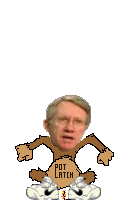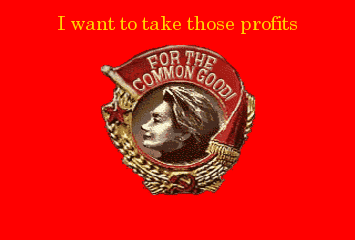






Posted on 03/09/2007 2:19:57 AM PST by FairOpinion
Hillary Clinton’s political methods were founded on the theories of a 1960s radical about whom she wrote her college thesis in 1969. It may take a village to raise a child, but Clinton’s college thesis seems to say that the village politicos need an enemy to mobilize against.
She titled the paper, written to fulfill her Bachelor of Arts degree at Wellesley College, “There is Only the Fight.” It praises the work of radical activist Saul Alinsky, a man who epitomized a self-interested no-holds barred campaign style that Hillary has emulated in later years. Clinton’s savvy-but-ruthless politics, including the “politics of personal destruction” she so often condemns but more often practices, seem rooted in Alinsky’s famous rules for radicals.
One year after Hillary turned in her thesis, Time Magazine profiled Alinsky. Their assessment was much different than hers. It said, “In his [Alinsky’s] view, the end of achieving power justifies a range of means…If the occasion requires, Alinsky’s forces will not refrain from spreading rumors about an antagonist or indulging in something that comes very close to blackmail.”
Young Hillary balked at Alinsky’s critics who said he was too extreme. In her college paper she professed, “Much of what Alinsky professes does not sound radical. His are the words used in our churches, by our parents and their friends, by our peers. The difference is that Alinsky really believes in them and recognizes the necessity of changing the present structures of our lives in order to realize them.” While she wrote, Hillary Rodham learned.
How We Got It
Hillary’s senior thesis has been the subject of much speculation among conservative writers. For years, it was under lock and key in the Wellesley archives while the Clintons were in the White House, but was quietly made available to the public in 2001.
A few weeks ago, a journalism student named Dorian Davis contacted me to see if I was interested in looking at it. He sought the document as part of a school project and for his website RepublicanSpectacular.com. He said he was going to write a story about the “hidden thesis” and to his surprise learned it was available through his college’s interlibrary loan program with Wellesley.
He said he received a copy of it in the mail and then transcribed it for his own records. He sent me an email copy of his transcription.
Wellesley officials refused to verify if Davis’s transcription was accurate, but did confirm he was given an official copy. Chief Archivist Wilma Slaight told me in an email she would not verify the copy I had. She wrote, “Due to limitations of staff and time, we are not able to asses whether the transcription in your possession is an accurate copy of Hillary Rodham’s 1969 Wellesley College honors thesis, entitled There is only the fight: An analysis of the Alinsky model.”
Slaight said “as a matter of college policy, a copy of student thesis is retained in the Wellesley College Archives. Theses may be read in the Archives reading room during our normal business hours.”
Clinton staff would not verify the document either. Spokesman Philippe Reines said in an email that, “Questions pertaining to the academic work of their [Wellesley] alumni should be directed to Wellesley College.”
Other media reports that have surfaced about the thesis are consistent with the copy we recieved.
The Need for an Enemy
In discussing the early stages of Alinsky’s career as a Chicago radical, Hillary said to be effective he needed “an enemy in order to translate community interest into community action.” She worried that “the complicating, overlapping layers comprising our interdependent urban areas today make it difficult to single out an ‘enemy’ “ and that “the lack of a clear-cut enemy against whom to mobilize underscored lack of community capable mobilization.”
The University of Chicago, which sought expansion in an area called Woodlawn, became one of Alinsky’s first targets. Hillary wrote, “With its predominantly black population, Woodlawn exemplified the disorganized anomic areas resulting from massive Negro migration to northern cities.” She described Woodlawn as “overcrowded, dilapidated housing, an increasing crime rate, high employment”
The city wanted to expand the University of Chicago into Woodlawn, but some community members were opposed to the development. Hillary sided with the residents, wondering, “how, indeed are bulldozers and cranes halted when they move with the encouragement of such powerful forces as the city administration and a university behind them?”
Alinsky staved off the expansion by creating and guiding a group called the Temporary Woodlawn Organization. Hillary wrote, “Alinsky argues that those who wish to change circumstances must develop a mass-based organization and be prepared for conflict….for him, conflict is the route to power.”
To force the University to meet their demands, TWO’s members sprawled out in front of bulldozers. Hillary applauded the action. She wrote:
“TWO then decided that the usually acquiescent city [should] defer its approval of the University plan until the city planners worked out a comprehensive prospectus on Woodlawn’s future. TWO accompanied its demand with the threat of demonstrators lying in front of bulldozers and hundreds of demonstrators at a City Plan Commission hearing. The demands, threats and demonstration created effective countervailing political pressure in the deferment of city approval.”
Later, “the University of Chicago launched a smear campaign against Alinsky” she wrote. She did not specify what attacks were. She only wrote “these charges were echoes of ones that Alinsky had heard before and answered before.”
As a national figure, Hillary famously implied said she was a victim of smear campaigns, when she told Matt Lauer in 1998 that “there is a vast right wing conspiracy that has been conspiring against my husband since the day he announced for president.” Alinsky as victim translated decades later into Clinton as victim.
Manipulation by Proxy
As a college student she apparently thought his approach to working with religious communities was novel. Hillary wrote, “He [Alinsky] never approached a Catholic Priest in terms of Christian ethics, but on the basis of self-interest such as the welfare of the Church, even in its physical property.” As a senator Hillary has modernized techniques Alinsky used to manipulate different organizations for political advantage. Clinton’s politics are not all manipulation. Like Alinsky’s radicalism, Clintonian politics uses alliances and acts through proxies to achieve advantage.
Hillary’s thesis explains how Alinsky used the church to organize Chicago’s Back of the Yards. She said the problem was that area was that is was "bigamously wedded to the meat-packing industry and the Roman Catholic Church.”
Although Alinsky was no believer in the church, he was eager to use it for his own gain. He successfully consolidated the power of the church with local unions and other groups to form a Neighborhood Council that supported the Packinghouse Strike of 1946. Hillary assessed, “the community backing of the strike resulted in both a good settlement for the workers and in a more powerful voice for the Council.”
Hillary has adopted similar strategies as a politician by marching to the church to mainstream her views on abortion and push for larger government welfare programs.
In 1997 she wrote a column that said, “after years of fiery rhetoric, finger pointing and heated recriminations, it’s time for people of good faith -- on all sides of the abortion issue -- to lower the decibel level and seek common ground.”
Hillary has long been a staunch supporter of legal, abortion on demand, but has teamed up with pro-life leaders to push for an increase in federal funding to promote sexual health awareness. In reality, such calls would only increase government funding to abortion providers such as Planned Parenthood.
Recently, she joined forces with the pro-life Senate Majority Leader Harry Reid (D.-Nev.) to talk about abortion “prevention.” The two co-authored a nationally published op-ed in April 2006 that sought agreement between far left and persons of faith on abortion. In a news conference held with Reid shortly after the column’s publication, Hillary said, “We are here together because we share the goal of reducing the number of unintended pregnancies, decreasing abortions and improving access to women's health care.”
In addition to her admiration of Alinsky’s ability to mobilize church-goers, young Hillary also commended how he organized corporate stockholders. She wrote in her thesis that leftist organizers should capitalize on the “great numbers of middle-class Americans suffering from feelings of powerlessness. They, who control the consumer market and the voting box, are bewildered by their children and by wars fought on television.”
She said the “frustration in the suburban ghettos, frequently directed at those even less powerful, could be channeled into achieving radical goals. The secret, as in any organizing, is that such goals must be perceives as paralleling self-interest. A good organizer could direct the process of perception as Alinsky did convincing stockholders to use their proxies to influence corporate policy.”
In a lengthy November 2006 piece she wrote for the Democratic Leadership Council’s Blueprint magazine, Hillary suggested that the middle class should be made to leverage pressure on corporate shareholders.
She called it “a new economic formula of Democratic Capitalism” and said it was “the way to ensure prosperity is to build an expanding middle class.”
Sen. Clinton then advised that corporations should “give the members of the middle class a stake in that prosperity” and that corporations should let “employers and investors draw their own conclusions about inflated CEO salaries by asking the Securities and Exchange Commission to require that corporations disclose full CEO compensation and how that relates to profitability and average worker pay.”
Mobilizations of communities, labeling adversaries as enemies and working through proxies are all Clinton trademarks. She is not a Saul Alinsky 1960s radical, but she has adapted and improvised his radical tactics to her own advantage.
I would say she is Stalin in a skirt, except she doesn't wear skirts.
When Josef Stalin was on his deathbed he called in two likely successors, to test which one of the two had a better knack for ruling the country.
He ordered two birds to be brought in and presented one bird to each of the two candidates.
The first one grabbed the bird, but was so afraid that the bird could free himself from his grip and fly away that he squeezed his hand very hard, and when he opened his palm, the bird was dead.
Seeing the disapproving look on Stalin's face and being afraid to repeat his rival's mistake, the second candidate loosened his grip so much that the bird freed himself and flew away.
Stalin looked at both of them scornfully. "Bring me a bird!" he ordered.
They did.
Stalin took the bird by its legs and slowly, one by one, he plucked all the feathers from the bird's little body.
Then he opened his palm. The bird was laying there naked, shivering, helpless.
Stalin looked at him, smiled gently and said, "You see... and he is even thankful for the human warmth coming out of my palm."
http://www.rjgeib.com/thoughts/stalin/stalin.html
ping
It is commonly known Hillary demanded the assault on the Branch Davidian compound near Waco which was a well-organized slaughter of men, women and children. Vince Foster knew of Hillary's key role.
Somebody put a bullet in his head and tossed his body in Fort Marcy Park and tried to make it look like a suicide.
That's a hint of what a monster like her can do when in power.
BILL, HILLARY, SAUL, AND MORAL RELATIVISM Saul Alinsky and the Lessons He Taught Bill and Hillary
FR POSTED | 03/23/00 | The Wanderer
http://www.freerepublic.com/focus/f-news/886451/posts
Rules for Radicals by Saul Alinsky Courtesy of The Wanderer.
Saul Alinsky wrote two books outlining his organizational principles and strategies: Reveille for Radicals (1946) and Rules for Radicals (1971).
Rules for Radicals opens with a quote about Lucifer, written by Saul Alinsky: “Lest we forget at least an over-the-shoulder acknowledgment to the very first radical: from all our legends, mythology, and history (and who is to know where mythology leaves off and history begins -- or which is which), the first radical known to man who rebelled against the establishment and did it so effectively that he at least won his own kingdom -- Lucifer.”
In Rules for Radicals, Alinsky says: “Here I propose to present an arrangement of certain facts and general concepts of change, a step toward a science of revolution.” He builds on the tactical principles of Machiavelli: “The Prince was written by Machiavelli for the Haves on how to hold power. Rules for Radicals is written for the Have-nots on how to take it away.”
Rules for Radicals is concerned with the acquisition of power: “my aim here is to suggest how to organize for power: how to get it and how to use it.” This is not to be done with assistance to the poor, nor even by organizing the poor to demand assistance: “...[E]ven if all the low-income parts of our population were organized ... it would not be powerful enough to get significant, basic, needed changes.”
Alinsky advises the organizer to target the middle class, rather than the poor: “Organization for action will now and in the decade ahead center upon America’s white middle class. That is where the power is.”
Alinsky is interested in the middle class solely for its usefulness: “Our rebels have contemptuously rejected the values and the way of life of the middle class. They have stigmatized it as materialistic, decadent, bourgeois, degenerate, imperialistic, war-mongering, brutalized and corrupt. They are right; but we must begin from where we are if we are to build power for change, and the power and the people are in the middle class majority.”
To accomplish this, Alinsky writes that the organizer must “begin to dissect and examine that way of life [the middle class lifestyle] ... He will know that ‘square’ is no longer to be dismissed as such -- instead his own approach must be ‘square’ enough to get the action started.”
Rules for Radicals defends belief that the end justifies the means: “to say that corrupt the ends,” writes Alinsky, “is to believe in the immaculate conception of ends and principles ... the practical revolutionary will understand ... [that] in action, one does not always enjoy the luxury of a decision that is consistent both with one’s individual conscience and the good of mankind.”
Altogether, Alinsky provides eleven rules of the ethics of means and ends. They are morally relativistic:
“The practical revolutionary will understand Goethe’s ‘conscience is the virtue of observers and not of agents of action’; in action, one does not always enjoy the luxury of a decision that is consistent both with one’s individual conscience and the good of mankind.”
“The second rule of the ethics of the means and ends is that the judgment of the ethics of means is dependent on the political position of those sitting in judgment.” Alinsky elaborates his meaning on this point, saying that if you were a member of the underground Resistance, “... then you adopted the means of assassination, terror, property destruction, the bombing of tunnels and trains, kidnapping, and the willingness to sacrifice innocent hostages to the end of defeating the Nazi’s. Those who opposed the Nazi’s conquerors regarded the Resistance as a secret army of selfless, patriotic idealists ....” Rules for Radicals is therefore concerned with how to win. “...[I]n such a conflict, neither protagonist is concerned with any value except victory.”
“The third rule of the ethics of means and ends is that in war the ends justifies almost any means.”
“There can be no such thing as a successful traitor, for if one succeeds, he becomes a founding father.”
Rules for Radicals teaches the organizer that he must give a moral appearance (as opposed to behaving morally): “All effective action requires the passport of morality.”
The tenth rule of the ethics of means and ends states “that you do what you can with what you have and clothe it with moral arguments ... Moral rationalization is indispensable at all times of action whether to justify the selection or the use of ends or means.”
Rules for Radicals provides the organizer with a tactical style for community organization that assumes an adversarial relationship between groups of people in which one either dominates or is dominated.
“The first rule of power tactics is: power is not only what you have but what the enemy thinks you have.”
“Wherever possible go outside the experience of the enemy. Here you want to cause confusion, fear, and retreat.”
“Make the enemy live up to their own book of rules. You can kill them with this. They can no more obey their own rules than the Christian church can live up to Christianity.”
Ridicule is man’s most potent weapon. It is almost impossible to counterattack ridicule. Also, it infuriates the opposition, who then react to your advantage.”
“The threat is generally more terrifying than the thing itself.”
“In a fight almost anything goes. It almost reaches the point where you stop to apologize if a chance blow lands above the belt.”
“Pick the target, freeze it, personalize it, and polarize it.”
One of the criteria for picking the target is the target’s vulnerability ... the other important point in the choosing of a target is that it must be a personification, not something general and abstract.”
“The enemy properly goaded and guided in his reaction will be your major strength.”
Saul Alinsky urged the active and deliberate “conscious-raising” (Ed note: a tactic used by feminists) of people through the technique of “popular education.” Popular education is a method by which an organizer leads people to a class-based interpretation of their grievances, and to accept the organizer’s systemic solutions to address those grievances. “Through the People’s Organization these groups [of citizens] discover that what they considered primarily their individual problem is also the problem of others, and furthermore the only hope for solving an issue of titanic proportions is by pooling all their efforts and strengths. That appreciation and conclusion is an educational process.”
Rules for Radicals stresses organizational power-collecting: “The ego of the organizer is stronger and more monumental than the ego of the leader. The organizer is in a true sense reaching for the highest level for which a man can reach -- to create, to be a ‘great creator’, to play God.” Alinsky considered Hillary a terrific “organizer” and wanted her to become his protege. She declined. She had bigger fish to fry. She learned her lessons well. She and Bill have employed Alinsky’s tactics probably better than anyone else.
Actually...
Conservative Thesis: The Village IS THE Enemy
Hold this thought!!!
"Somebody put a bullet in his head and tossed his body in Fort Marcy Park and tried to make it look like a suicide."
That's not the scary part. It was covered up by the police. The Clintons have the power to come into your house, violate every one of your civil rights, rape you, steal from you and toss you into a cell and there wouldn't be a thing you could do about it.
That's what is scary. And Americans are too stupid to see it.
Thank you for that link.
Don't miss post 5
bump for later
A good example is the Taco Bell boycott tour. Now they are attacking McDonalds and other franchises. Today taco bell, tomorrow the world...
"I DON'T FEEL NO WAYS TIRED, I COME TOO FARRRR FRUM WHERE I STARTED FRUM. NOBODY TOLD ME THAT THE ROAD WOULD BE EASY."
Even the most ignorant of potential Hillary voters can see that this "woman" is an empty pants suit who has never, in her vast political career as governor and co-president, uttered a sensible sentence.
"She said the “frustration...could be channeled into achieving radical goals. The secret, as in any organizing, is that such goals must be perceived as paralleling self-interest."
Anybody see the parallel with the Rudymaniacs, who exploit Republican "frustration" with losing and fear of Hellary to foist their left-wing candidate on us?
Interesting that Alinsky openly speaks of admiration for Lucifer. Those of us with a Christian spiritual perspective have long recognized that leftists are just following the example of the Father of Lies. Satan's shtick in the Garden was "God didn't really tell you not to do that, did he", then "you can be your own gods."
Today we are told that "God said not to kill, but he didn't really include 'fetuses.'" We get twisted sophistry about "being personally opposed to abortion, but...." We get endless appeals to selfishness and greed by "fiscal-only" "conservatives," free-traders, and utopian libertarians. All of which follow the ancient prototype, which Alinsky advocated, but which far predates him.
Good point.
Okay---will do.
Disclaimer: Opinions posted on Free Republic are those of the individual posters and do not necessarily represent the opinion of Free Republic or its management. All materials posted herein are protected by copyright law and the exemption for fair use of copyrighted works.